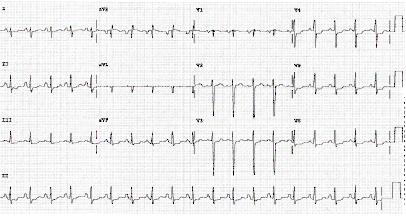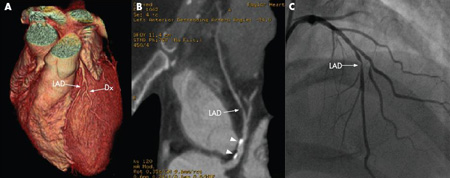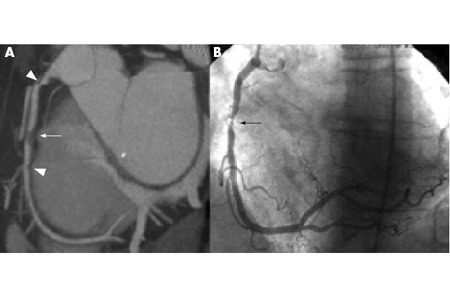Tests
1st tests to order
ECG
Test
A 12-lead ECG should be performed and interpreted within 10 minutes of the point of first medical contact in any patient with suspected non-ST-elevation myocardial infarction (NSTEMI).[5][80] Classic ECG findings of ischemia in NSTEMI include horizontal or downsloping ST depression >1.0 mm and/or symmetrically inverted T waves (Wellens waves).[Figure caption and citation for the preceding image starts]: ECG showing ST depressionFrom the personal collection of Dr Syed W. Yusuf and Dr Iyad N. Daher, Department of Cardiology, University of Texas, Houston; used with permission [Citation ends]. [Figure caption and citation for the preceding image starts]: ECG showing ST depressionFrom the personal collection of Dr Syed W. Yusuf and Dr Iyad N. Daher, Department of Cardiology, University of Texas, Houston; used with permission [Citation ends].
[Figure caption and citation for the preceding image starts]: ECG showing ST depressionFrom the personal collection of Dr Syed W. Yusuf and Dr Iyad N. Daher, Department of Cardiology, University of Texas, Houston; used with permission [Citation ends].
In many patients the ECG may be normal and in some patients there may be transient ST elevation.
Serial ECGs, initially at 15- to 30-minute intervals, then per provider discretion, should be taken in patients with chest pain, to detect development of ST-elevation myocardial infarction (MI), or to help guide reperfusion strategies.[2]
Continuous 12-lead ECG monitoring is a reasonable alternative to serial 12-lead recordings in patients whose initial ECG is nondiagnostic.[2]
Supplemental ECG leads V7 through V9 may be useful in patients with nondiagnostic initial ECGs to rule out MI due to left circumflex occlusion, and V3R and V4R may be useful to detect right ventricular MI.[5]
Result
nonspecific ST-T wave changes or ischemic changes
cardiac biomarkers
Test
Troponin levels confirm the diagnosis of infarction.[80] Test is the best marker for musculoskeletal injury, small myocardial infarction (MI), or late (>2-3 days) MI.
The 99th percentile is the cutoff value used to determine acute MI.
This test is readily available at most institutions. Cardiac troponins are more sensitive and specific markers of cardiomyocyte damage than creatine kinase (CK), its myocardial band isoenzyme (CK-MB), and myoglobin. In patients with MI, troponin levels rise rapidly (usually within 1 hour from symptom onset if using high-sensitivity assays) and remain elevated for several days. Therefore, with the advent of high-sensitive troponin assays (hs-cTn), do not use other biomarkers (e.g., CK, CK-MB, and myoglobin) to diagnose non-ST-elevation myocardial infarction.[4][5][7][82][83] Similarly, for initial diagnostic purposes, routine measurement of additional biomarkers (e.g., heart-type fatty acid-binding protein [h-FABP] or copeptin) is not recommended in addition to hs-cTn.[5]
For interpretation of hs-cTn, European Society of Cardiology recommends using the 0/1 hour or 0/2 hour “rule in” and “rule out” algorithms, which classify patients into one of three pathways according to the results of their hs-cTn values at 0 hours (time of initial blood test) and 1 hour or 2 hours later.[5]
Rule-out pathway: for very low initial hs-cTn or no increase after 1/2 hours: these patients may be appropriate for early discharge and outpatient management.
Rule-in pathway: for high initial hs-cTN or an increase after 1-2 hours: most of these patients will require hospital admission and further evaluation.
Observe pathway: if neither of the above criteria is met: check hs-cTN at 3 hours and consider echocardiography.
Alternative causes for elevated troponin levels should also be considered. These may be cardiac (e.g., myocarditis, aortic dissection, severe heart failure) or noncardiac (e.g., pulmonary embolism, impaired renal function, underlying sepsis).[79] It is important to remember that even with an alternative underlying cause, raised troponin may still indicate myocardial injury.
Result
>99th percentile of normal
echocardiography
Test
Cardiac ultrasound may be useful for early triage of patients with suspected myocardial infarction (MI).[4] An urgent echocardiogram should always be performed in patients with cardiogenic shock or hemodynamic instability.[5][84]
Point-of-care transthoracic echocardiogram can also be used to look for regional wall motion abnormalities of the left ventricle in patients with an atypical presentation or equivocal ECG, look for mechanical complications of acute MI (such as left ventricular function, right ventricular function, ventricular septal rupture, left ventricular free wall rupture, acute mitral regurgitation, pericardial effusion, cardiac tamponade) and for evidence to suggest alternative etiologies associated with chest pain (e.g., acute aortic disease, pulmonary embolism).[2][4][5][85][84] A predischarge echocardiogram is indicated for all patients post-acute MI to assess left ventricular function after coronary reperfusion therapy and to guide prognostication.[86][87]
Result
regional wall motion abnormality, depressed left ventricular function, or decreased ejection fraction
CXR
Test
To exclude causes for chest pain such as pneumothorax or a widened mediastinum in aortic dissection, or complications of acute coronary syndrome (ACS) such as pulmonary edema due to heart failure.[80]
Result
normal or may show other causes of acute chest pain, such as pneumothorax or a widened mediastinum in aortic dissection, or complications of ACS, such as pulmonary edema due to heart failure
CBC
Test
Hemoglobin and hematocrit measurements may help to evaluate a secondary cause of non-ST-elevation myocardial infarction (e.g., acute blood loss, anemia) and to evaluate thrombocytopenia to estimate risk of bleeding.
Result
normal, anemia, thrombocytopenia
BUN and serum creatinine
Test
Creatinine clearance should be estimated in non-ST-elevation myocardial infarction patients and the doses of renally cleared drugs should be adjusted appropriately. In chronic kidney disease patients undergoing angiography, iso-osmolar contrast agents may be preferred.[89]
Result
normal or elevated
electrolytes
Test
Electrolyte derangements may predispose to cardiac arrhythmias.
Result
normal or deranged
LFTs
Test
Useful if considering treatment with drugs that undergo hepatic metabolism, and in the assessment of bleeding risk before starting anticoagulation.
Impaired LFTs may also suggest hepatic congestion in patients with concomitant heart failure.
Result
normal
blood glucose
CRP
Test
CRP is commonly ordered to rule out other causes of acute chest pain (e.g., pneumonia).
Result
elevated if infection present
Investigations to avoid
coronary artery calcium (CAC)
Tests to consider
angiography/cardiac catheterization
Test
Urgent and immediate angiography is indicated if the patient is clinically unstable or has any very high risk features: ongoing or recurrent pain despite treatment, hemodynamic instability (low blood pressure or shock) or cardiogenic shock, recurrent dynamic ECG changes suggestive of ischemia, a life-threatening arrhythmia (ventricular tachycardia or ventricular fibrillation) or cardiac arrest after presentation, or mechanical complications such as new onset mitral regurgitation.[2][5][97][Figure caption and citation for the preceding image starts]: 64-slice CT angiography of a patient with stable angina showing 3D reconstruction (A), curved reformatted images (B) and confirmation of a high-grade lesion on conventional angiography (C). The arrowheads show calcified plaques. Dx= diagnosisFrom: Schussler JM and Grayburn PA. Heart. 2007 Mar;93(3):290-7 [Citation ends]. [Figure caption and citation for the preceding image starts]: 64-slice CT angiography (A) and conventional angiography (B) showing a high-grade lesion in the mid-right coronary artery, indicated by the arrows. The arrowheads show artifacts that may be mistaken for lesionsFrom: Schussler JM and Grayburn PA. Heart. 2007 Mar;93(3):290-7 [Citation ends].
[Figure caption and citation for the preceding image starts]: 64-slice CT angiography (A) and conventional angiography (B) showing a high-grade lesion in the mid-right coronary artery, indicated by the arrows. The arrowheads show artifacts that may be mistaken for lesionsFrom: Schussler JM and Grayburn PA. Heart. 2007 Mar;93(3):290-7 [Citation ends].
Renal failure is a relative contraindication and patients with contrast allergy must be premedicated prior to angiography.
Result
severe stenosis or thrombosis
lipids
Test
Lipid management should include assessment of a fasting lipid profile for all patients, within 24 hours of admission to the hospital. Frequently, in the acute phase of an acute coronary syndrome, lipid values may be lower than normal for that patient.
Result
elevated, normal, or optimal
brain natriuretic peptide (BNP) or N-terminal pro-BNP (NT-pro-BNP)
Test
Measurement of BNP or NT-pro-BNP may be considered to supplement assessment of global risk in patients with suspected acute coronary syndrome.[5]
Result
>99th percentile of normal
stress testing
Test
Stress testing, including treadmill exercise testing, may be useful and is recommended in patients with low and intermediate pretest probability with a normal ECG and normal high sensitivity biomarkers to assist with assessing need for an invasive strategy.[2][98][99]
The sensitivity and specificity of these tests increase when combined with either nuclear imaging to look for myocardial perfusion defects or echocardiography to assess wall motion abnormalities.
The key positive finding on nuclear imaging stress tests is the presence of a reversible defect. This is an area of myocardium that becomes deprived of perfusion during increased myocardial demand and reperfuses on stopping the activity. This signifies stenosis within the coronary circulation that may be treated with percutaneous coronary intervention or coronary artery bypass graft.
Submaximal exercise testing can be performed at 4-7 days after myocardial infarction, while symptom limited testing can be performed at 14-21 days post-myocardial infarction, when the patient has been free of active ischemic or heart failure symptoms.[100]
High risk patients should be considered for invasive strategy instead of stress testing.[101]
Result
ECG: ST-segment depression >1mm (0.1 mV); nuclear imaging: reversible or fixed perfusion defect
coronary CT angiography (CCTA)
Test
May provide noninvasive evaluation of coronary anatomy and atherosclerosis.[102] Renal failure is a relative contraindication. Patients with a contrast allergy should be premedicated prior to angiography.[Figure caption and citation for the preceding image starts]: 64-slice CT angiography (A) and conventional angiography (B) showing a high-grade lesion in the mid-right coronary artery, indicated by the arrows. The arrowheads show artifacts that may be mistaken for lesionsFrom: Schussler JM and Grayburn PA. Heart. 2007 Mar;93(3):290-7 [Citation ends]. [Figure caption and citation for the preceding image starts]: 64-slice CT angiography of a patient with stable angina showing 3D reconstruction (A), curved reformatted images (B) and confirmation of a high-grade lesion on conventional angiography (C). The arrowheads show calcified plaques. Dx= diagnosisFrom: Schussler JM and Grayburn PA. Heart. 2007 Mar;93(3):290-7 [Citation ends].
[Figure caption and citation for the preceding image starts]: 64-slice CT angiography of a patient with stable angina showing 3D reconstruction (A), curved reformatted images (B) and confirmation of a high-grade lesion on conventional angiography (C). The arrowheads show calcified plaques. Dx= diagnosisFrom: Schussler JM and Grayburn PA. Heart. 2007 Mar;93(3):290-7 [Citation ends].
Due to the high negative predictive value of CCTA, evidence suggests that CCTA is useful in patients with low to moderate risk of non-ST-elevation myocardial infarction. When compared with the standard care of low-risk patients (observation, serial enzymes followed by stress testing) CCTA reduced time to diagnosis, reduced length of emergency department stay, and had similar safety.[103] CCTA is not indicated for patients with high-risk features (i.e., ischemic ECG changes, positive cardiac markers) so should not be used in high-risk emergency department patients presenting with acute chest pain.[5][84][95][104]
Result
occlusion or near-occlusion
Use of this content is subject to our disclaimer